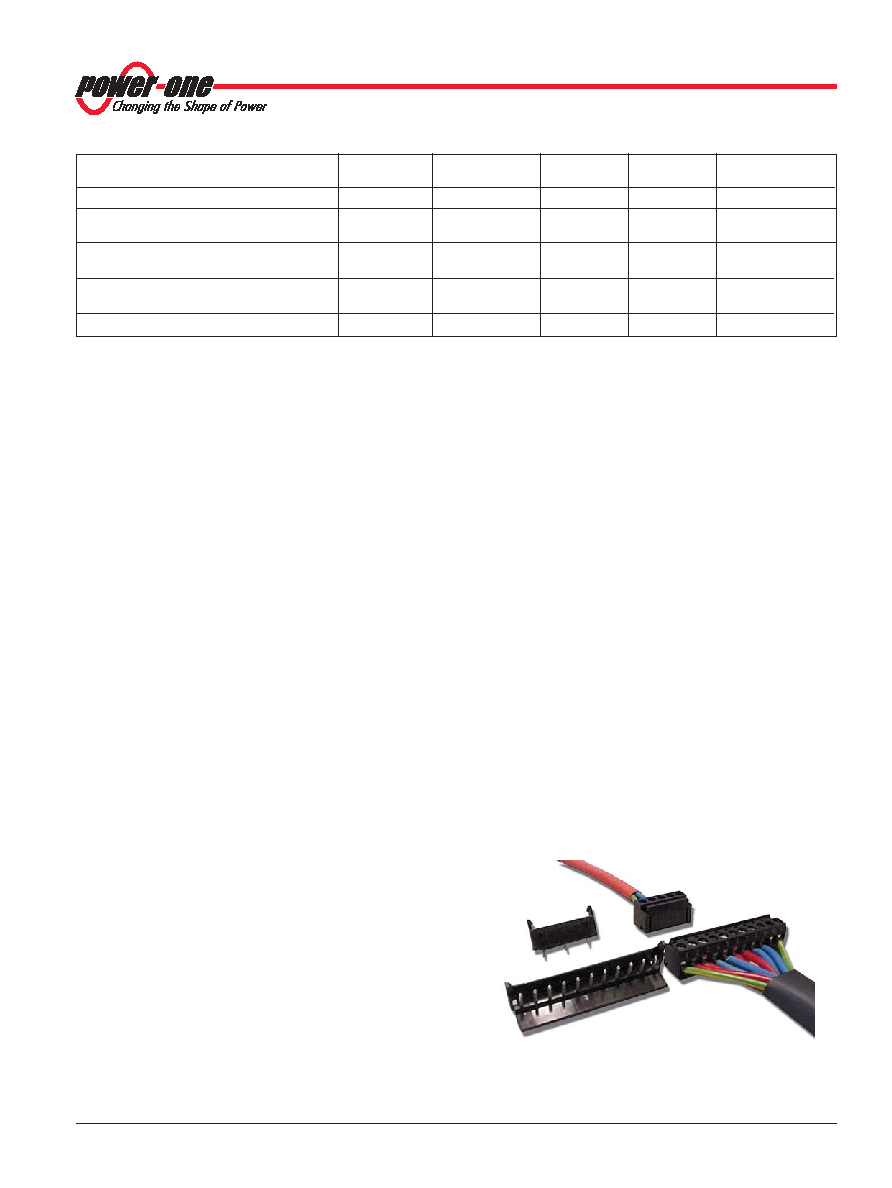- 您現(xiàn)在的位置:買賣IC網(wǎng) > PDF目錄45005 > LWN2770-6ERD5M1FK2G (POWER-ONE INC) 2-OUTPUT DC-DC REG PWR SUPPLY MODULE PDF資料下載
參數(shù)資料
| 型號: | LWN2770-6ERD5M1FK2G |
| 廠商: | POWER-ONE INC |
| 元件分類: | 電源模塊 |
| 英文描述: | 2-OUTPUT DC-DC REG PWR SUPPLY MODULE |
| 封裝: | ROHS COMPLIANT PACKAGE-5 |
| 文件頁數(shù): | 16/25頁 |
| 文件大?。?/td> | 758K |
| 代理商: | LWN2770-6ERD5M1FK2G |

BCD20020-G Rev AB1, 17-Nov-09
Page 23 of 25
www.power-one.com
W Series Data Sheet
125, 250 Watt AC-DC and DC-DC DIN-Rail Converters
Fig. 24
System connectors Option K2
R: Adjustment of Vo or Vo2
The R input allows external adjustment of the output voltage in
the range of 50% to 110% Vo nom. Double-output models allow
only adjustment of output 2 (connected to the terminals 6, 7, 8
and 9). This enables asymmetric output voltage configuration.
Adjustment can be achieved via a resistor or an external
voltage source (in the range of 1.25 – 2.75 V).
Note: If the R input is not connected: Vo or Vo2
≈ Vo nom.
a) Adjustment by an external resistor:
Resistor Rext1, connected between R (pin 2) and GND1 (pin
1) of the D-SUB connector or according to fig. 20.
Vo
Vo = 50 – 100% Vo nom. Rext1
≈ 4 k –––––––––
Vo nom – Vo
Resistor Rext2, connected between R (pin 2) and VCC (pin 3)
of the D-SUB connector or according to fig. 20.
Vo – 2.5 V
Vo = 100 – 110% Vo nom. Rext2
≈ 4k––––––––––––––––
2.5 V(Vo / Vo nom –1)
Note: If the R function is not included in M1 or M2, refer to figure
20 how to connect
Rext1 or Rext2 .
b) Adjustment by an external control voltage Vext (1.25 – 2.75
V), connected between R (pin 2) and GND (pin 1) of the D-
SUB connector or according to fig. 20.
Vo
Vext
Vext
≈ 2.5 V –––––
Vo
≈ Vo nom ––––
Vo nom
2.5 V
Caution: To prevent damage, Vext should not exceed 3 V, nor be
negative.
Note: If longer wires are used to connect the R input at the D-SUB
connector, the wiring to pin 1 (GND1) should be done as star point
connection. If wired differently, the output voltage setting may be
adversely affected.
In battery charging systems, an external battery temperature
sensor (see Accessories) can be connected to optimize Vo.
However, adjustment using the R input (pin 2 of D-SUB) is
possible as well. The above shown formulas are valid, but
Vo nom stands for the voltage with open R input (= Vo safe).
F: Built-in Second Fuse
A built-in second fuse in the neutral line provides safe phase-
to-phase connection at low mains voltages (e.g., USA 120 V/
208 V / 60 Hz systems).
The built-in second fuse also enables safe connection to the
mains, where phase and neutral are not defined or cannot be
identified, as e.g., in the case of plug and socket connection to
the mains via German Schuko-plugs; see also Safety and
Installation Instructions.
Option F limits the DC input voltage to
≤ 250 V.
Q: Reverse Polarity Protection
EW models have no bridge rectifier at the input. To provide
reverse polarity protection, an additional diode can be fitted.
However this lowers the efficiency by approximately 1%.
K2: System Connectors
For installation in systems using pre-assembled harnesses the
converters are available with system connectors. They are UL-
listed, approved for currents up to 15 A at –40 to 105 °C.
The mating system connectors with screw terminals and
retainers are delivered together with every converter with
option K2. Use max. 2.5 mm2 (AWG 12) solid or stranded
wires, or max. 1.5 mm2 (AWG 14) stranded wires with crimp
termination, stripped length 6 mm. Tightening torque of input/
output terminals: max. 0.79 Nm (7 lbs.in.).
G: RoHS
RoHS compliant for all six substances.
Table 19: System OK (M1 with external battery sensor)
System Status
Input
Vcontrol
VBat
Sys-OK
sensor signal
theoretical
measured
output
System OK
O.K.
2.7 V
27 V
Low ohmic
Battery overchared / temp. sensor
O.K.
2.7 V
27 V
28 V
High ohmic
defect / control voltage to high
Overload, converter cannot follow the
O.K.
2.7 V
27 V
24 V
High ohmic
control signal
Output does not follow control signal,
O.K.
3.0 V
30 V
27 V
High ohmic
since battery would be overcharged
System OK
O.K.
2.5 V
25 V
25V
Low ohmic
相關PDF資料 |
PDF描述 |
|---|---|
| LWN2660-6ERD1M2FK2G | 2-OUTPUT DC-DC REG PWR SUPPLY MODULE |
| LWN2660-6ERD2M2FK2G | 2-OUTPUT DC-DC REG PWR SUPPLY MODULE |
| LWN2770-6ERD1M1FK2G | 2-OUTPUT DC-DC REG PWR SUPPLY MODULE |
| LWN2660-6ERD5M1FK2G | 2-OUTPUT DC-DC REG PWR SUPPLY MODULE |
| LWR1801-6ERD2M1FK2G | 1-OUTPUT DC-DC REG PWR SUPPLY MODULE |
相關代理商/技術參數(shù) |
參數(shù)描述 |
|---|---|
| LWN2880-6 | 制造商:Power-One 功能描述:AC/DC PS DUAL-OUT 49.36V 5A 250W 5PIN - Bulk |
| LWN2880-6E | 功能描述:DC/DC轉換器 DIN Rail 247W (2x 49.4V) RoHS:否 制造商:Murata 產(chǎn)品: 輸出功率: 輸入電壓范圍:3.6 V to 5.5 V 輸入電壓(標稱): 輸出端數(shù)量:1 輸出電壓(通道 1):3.3 V 輸出電流(通道 1):600 mA 輸出電壓(通道 2): 輸出電流(通道 2): 安裝風格:SMD/SMT 封裝 / 箱體尺寸: |
| LWN28806ED2F | 制造商:Power-One 功能描述: |
| LWN2880-6EG | 制造商:Power-One 功能描述:DIN RAIL 247W 2X 49.4V |
| LWN2880-6E-G | 功能描述:DC/DC轉換器 250W W-DIN-Rail Converters DUAL OUT RoHS:否 制造商:Murata 產(chǎn)品: 輸出功率: 輸入電壓范圍:3.6 V to 5.5 V 輸入電壓(標稱): 輸出端數(shù)量:1 輸出電壓(通道 1):3.3 V 輸出電流(通道 1):600 mA 輸出電壓(通道 2): 輸出電流(通道 2): 安裝風格:SMD/SMT 封裝 / 箱體尺寸: |
發(fā)布緊急采購,3分鐘左右您將得到回復。